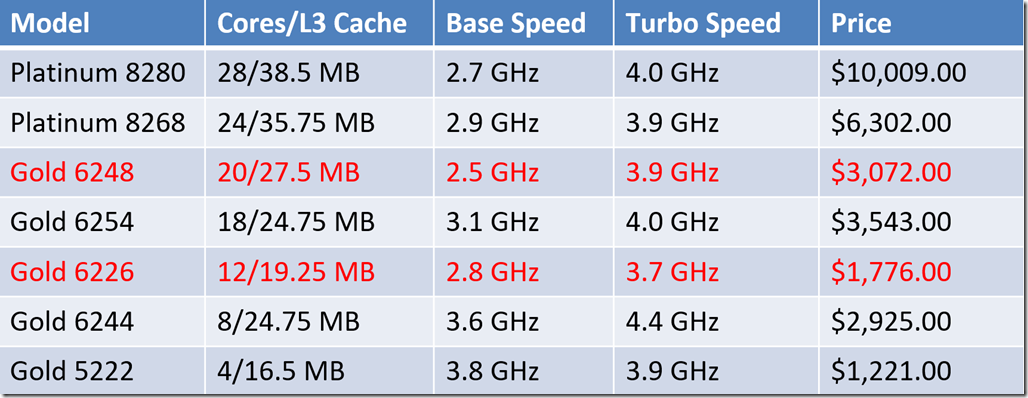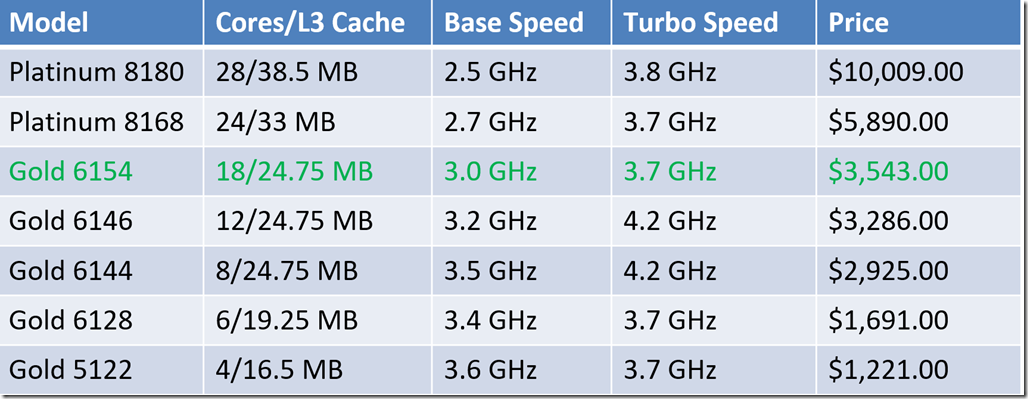Introduction
On April 2, 2019, Intel had their Data-Centric Innovation Day, where they announced and described a number of new products for data center use. Most relevant from a SQL Server perspective is the 2nd Generation Intel Scalable Processor family, aka Cascade Lake-SP. This line of 14nm processors are the successor to the existing 14nm Intel Scalable Processor family (Skylake-SP) that was released in Q3 2017. These new processors will work with existing model servers (with a BIOS update), so there should be no delay waiting on server vendors to do a model refresh.
Cascade Lake-SP Improvements
This new family of processors has minor base and turbo clock speed improvements (typically 200 MHz). They also support DDR4-2933 RAM (at two DIMMs per channel) and 256GB LRDIMMs. This means you can have up to 1.5TB of RAM per socket, with the base, non-M or L suffix SKUs. That is a doubling of memory capacity compared to Skylake-SP. Some of the mid-range Cascade Lake-SP SKUs have larger L3 cache sizes compared to the equivalent Skylake-SP SKUs. Cascade Lake-SP also has Optane DC Persistent Memory support and hardware-level Spectre and Meltdown mitigations. Unfortunately, there is no PCIe 4.0 support with Cascade Lake-SP.
Cascade Lake-SP Regressions
There are some issues with Cascade Lake-SP for SQL Server usage. Not from a technical or performance perspective, but from a product segmentation perspective. First, Intel has introduced a number of new model number letter suffixes which make processor selection more complicated and potentially much more expensive.
The complete list of SKU suffix letters are as follows:
- No letter = Normal Memory Support (1.5 TB)
- M = Medium Memory Support (2.0 TB)
- L = Large Memory Support (4.5 TB)
- Y = Speed Select Models
- N = Networking/NFV Specialized
- V = Virtual Machine Density Value Optimized
- T = Long Life Cycle/Thermal
- S = Search Optimized
Confused yet? Suffice it say, you will want to avoid those specialized SKUs for most SQL Server usage, with the possible exception of the M or L models if you need higher memory density. Another exception might be the “Y”, Speed Select (SST) SKUs, which let you pin workloads to specific cores (which can have an increased base clock speed) while the other cores have a reduced base clock speed. Another variant of Speed Select (SST-PP) lets you vary the number of cores and clock speeds at boot time. This feature would probably be in violation of current SQL Server licensing, where Microsoft expects you to pay for all of the physical cores in a machine, whether they are enabled or not.
If you decide to use Intel Optane DC Persistent Memory, your maximum memory speed will be reduced to DDR4-2666. Intel has not released pricing for Intel Optane DC Persistent Memory yet, which means that it will be expensive (but less expensive/GB than DDR4 RAM).
Missing SKUs
A bigger issue for SQL Server usage is the fact Intel has apparently dropped at least two of their frequency-optimized SKUs from the previous generation. Based on today’s information, I don’t see a 12-core Intel Xeon Gold 6246 or a 6-core Intel Xeon Gold 6228. These would replace the previous Intel Xeon Gold 6146 and Intel Xeon Gold 6128. There don’t appear to be any 6-core SKUs outside of the Intel Xeon Bronze 3204 (which would be a terrible choice for SQL Server usage).
In fact, there are only five specific Cascade Lake-SP SKUs that I really like for SQL Server usage (if you want the best single-threaded performance possible). These include:
- Intel Xeon Platinum 8280 (28 cores)
- Intel Xeon Platinum 8268 (24 cores)
- Intel Xeon Gold 6254 (18 cores)
- Intel Xeon Gold 6244 (8 cores)
- Intel Xeon Gold 5222 (4 cores)
All of these SKUs have slightly higher base and turbo clock speeds than their direct Skylake-SP predecessors. All of them (except the Platinum 8168) are the same price as their predecessors. The Platinum 8268 has a larger L3 cache than the Platinum 8168, which somewhat justifies a price increase. The problem is that missing 6-core SKU and the big gap between the 8-core and the 18-core SKUs. That gap represents about $142K in SQL Server 2017 Enterprise Edition licenses costs in a two-socket server.
Figures 1 and 2 show the main specifications for my preferred SKUs for Cascade Lake-SP and Skylake-SP (for SQL Server usage).
Figure 1: Preferred Cascade Lake-SP SKUs
As you can see, there were fewer large gaps in the core counts of these “good” processor choices for SQL Server usage with Skylake-SP.
Figure 2: Preferred Skylake-SP SKUs
Initial TPC-E Results
We already have the first TPC-E submission for a system using Cascade Lake-SP processors. Lenovo recently submitted a result for a two-socket Lenovo ThinkSystem SR650 with two Intel Xeon Platinum 8280 processors. This system had a score of 7012.53. If you divide that score by 56 physical cores, you get a result of 125.22/core.
Lenovo previously submitted a result for an essentially identical Lenovo ThinkSystem SR650 with two Intel Xeon Platinum 8180 processors This system had a score of 6779.53. If you divide that score by 56 physical cores, you get a result of 121.06/core.
That is about a 3.4% improvement. The difference in base clock speed is 8%. Both systems are running SQL Server 2017 Enterprise Edition on Windows Server 2016 Standard Edition. There may be some minor configuration differences between the two systems, but I have not spelunked into the full disclosure reports to determine that yet.
Conclusion
Cascade Lake-SP will give give you marginally better performance at the same core counts compared to Skylake-SP. This is primarily due to the higher base and turbo clock speeds. Higher memory bandwidth and hardware-level Spectre/Meltdown protection will also help in some scenarios. Most of the other Cascade Lake-SP improvements are focused on HPC and AI workloads, and will not be beneficial to SQL Server 2017/2019. Intel is not claiming any significant IPC improvements in Cascade Lake-SP, which seems to be confirmed by the first TPC-E result. Intel Optane DC Persistent Memory may be useful, depending on how much you can leverage it with SQL Server 2019.
Honestly, I am pretty underwhelmed by Cascade Lake-SP so far, at least for SQL Server. It is slightly better than Skylake-SP, assuming the frequency-optimized core count gaps don’t force you to license more cores than you wanted to. Intel should be very concerned about the upcoming 7nm AMD EPYC “Rome” server processors. These AMD processors will have have up to 64C/128T, higher memory density, and more PCIe lanes (with PCIe 4.0 instead of PCIe 3.0). They also may have higher single-threaded performance than Cascade Lake-SP. This is especially likely if AMD decides to offer more frequency-optimized SKUs, like the existing AMD EPYC 7371 from the “Naples” generation.



One thought on “Intel Cascade Lake-SP Processor Analysis for SQL Server”